Ever wondered if dragons could be real? These fire-breathing beasts of Arthurian legend, Tolkien tales, and video game backdrops? Could dragons be real? Is there any evidence from science that proves they once existed? Or are these beasts just a giant myth?
Let’s take a look.
Were Dragons Real?
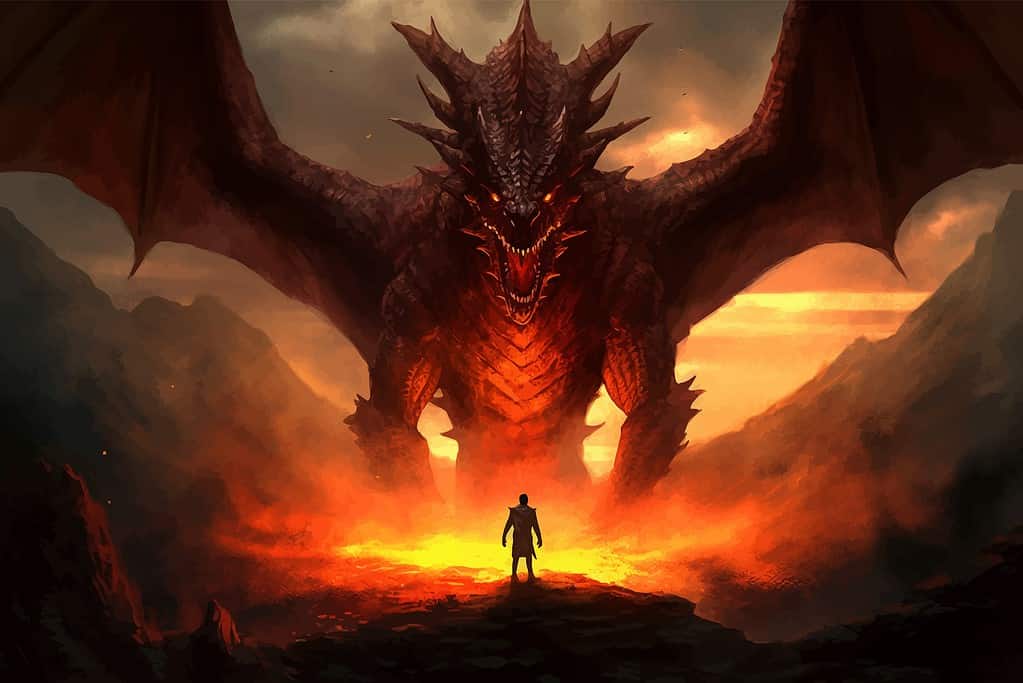
Across the world, dragons make their way into legends of nearly every culture. With some massive, like this Lord of the Rings-esque depiction to the Chinese snake-dragon, you’ll find the immense beasts everywhere. But did they ever live on planet Earth? Were dragons real?
©Elena Zakhariya/Shutterstock.com
No confirmed evidence provides us with solid, undeniable proof that dragons existed. However, like other now extinct animals once thought myths but later proven real, there’s a slight possibility that these creatures indeed did once exist. Some argue that without proof we cannot speculate and must confirm a lack of real dragons in the world. On the other hand, we have stories of dragons that come from nearly every culture of the world. We also have depictions and descriptions of the beasts in multiple manuscripts dating back millennia.
Dragons could be the precursors to modern day lizards or they might merely have been mythical beings dreamt up from known animals like crocodiles and Komodos and dinosaurs. It’s also possible that they were dinosaurs but changed in the imagery shared among cultures.
Religious texts of many cultures specifically include descriptions and stories of dragons, even fire-breathing dragons. One example comes from the Christian Bible or the Torah in the book of Job. Yahweh, God, speaks to a man named Job, describing a smoke-snorting beast that swims, has scales like armor, and reptilian qualities. Some claim these are dragons (Leviathans) while others dismiss the translation as fantasy. Many also believe that sea dragons evolved eventually into marine reptiles in the Mesozoic period.
If dragons did exist, they would look similar to lizards or dinosaurs, depending on the species.
Dragons in Nearly Every Culture
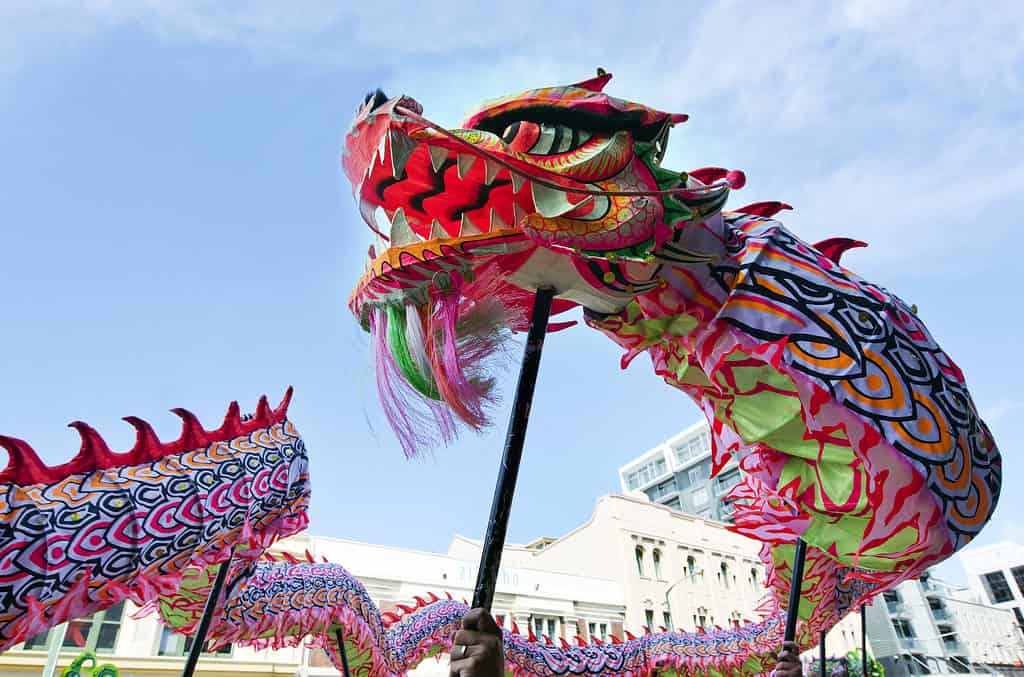
If you explore mythology and legends of nearly any culture, you’ll find tales of dragons. But this is the only “proof” we have for the existence of dragons in ancient times.
©ChameleonsEye/Shutterstock.com
Draconic creatures have been recorded in nearly every culture around the world. Early depictions describe snake-like beings, though the earliest depictions come from the ancient Near East and ancient Mesopotamian art and literature. Gods and heroes shown to kill off these giant serpentine beasts falls into nearly every Near Eastern and Indo-European mythology. You’ll find mentions of dragons in religious texts as well, like in the Hebrew Bible.
Some famous dragons include:
- Apep from Egyptian mythology
- Vrta from Rigveda (India)
- Mušḫuššu from ancient Mesopotamian mythology
- Leviathan from the Hebrew and Christian religious texts (Torah, Bible)
- Grand’Goule from French mythology
- Python, Ladon, Kulshedra, and Wyvern from Albanian mythology
- Lernaean Hydra from Greek mythology
- Unhcgila from Lakota mythology
- Jörmungandr, Fafnir, and Níðhöggr from Norse mythology
- The dragon from Beowulf
- Aži and Az in ancient Persian mythology
Chinese Water Dragon

You’ll find the Chinese Water Dragon looks a bit like the mythological beasts of old. These small lizards live in Asia and are among some of the most popular pets today.
©Tom Meaker/iStock / Getty Images Plus via Getty Images
Native to east China, the Chinese water dragon makes for an excellent modern day dragon substitute. The small lizards live in many parts of Asia, including Burma, Laos, Cambodia, Vietnam, and Thailand, in forests near freshwater lakes and streams. The popular pet species is usually a wild-caught animal, so be careful when bringing them home for your own dragon enclosure. The lizards mostly come in greens, though that color may vary from light to dark, depending on the animals. They also have brown bands on their tails, and rough scales over their bodies, looking a bit like armor. Spikes cover male bodies, making them fairly easy to sex. These lizards can’t live in the water but they can hold their breath and hang out underwater for up to 90 minutes.
Bearded Dragon
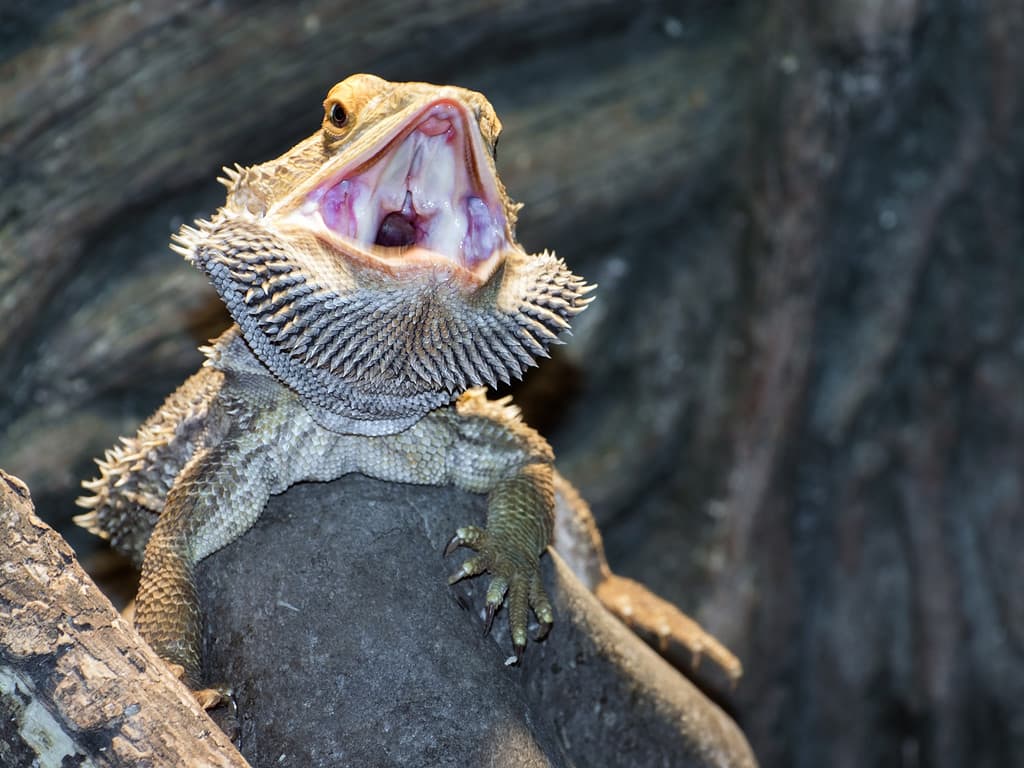
Coming from Australia, the Bearded Dragon is not only a popular pet lizard, but it looks like its namesake, the dragon.
©belizar73/iStock via Getty Images
An Australian critter, the bearded dragon is perhaps the most well-known dragon-like creature today. With six different species of bearded dragons in the Land Down Under, the popular pet naturally inhabits woodlands, deserts, and savannas, making them moderately easy to care for. The animal gets its name from the spikes under its neck, which it puffs out when it feels threatened. The spikes run down their backs, as well, offering an even more dragon-like appearance. These tiny dragons come in a wide range of colors and sizes and generally is pretty docile and easy to care for.
Komodo Dragon
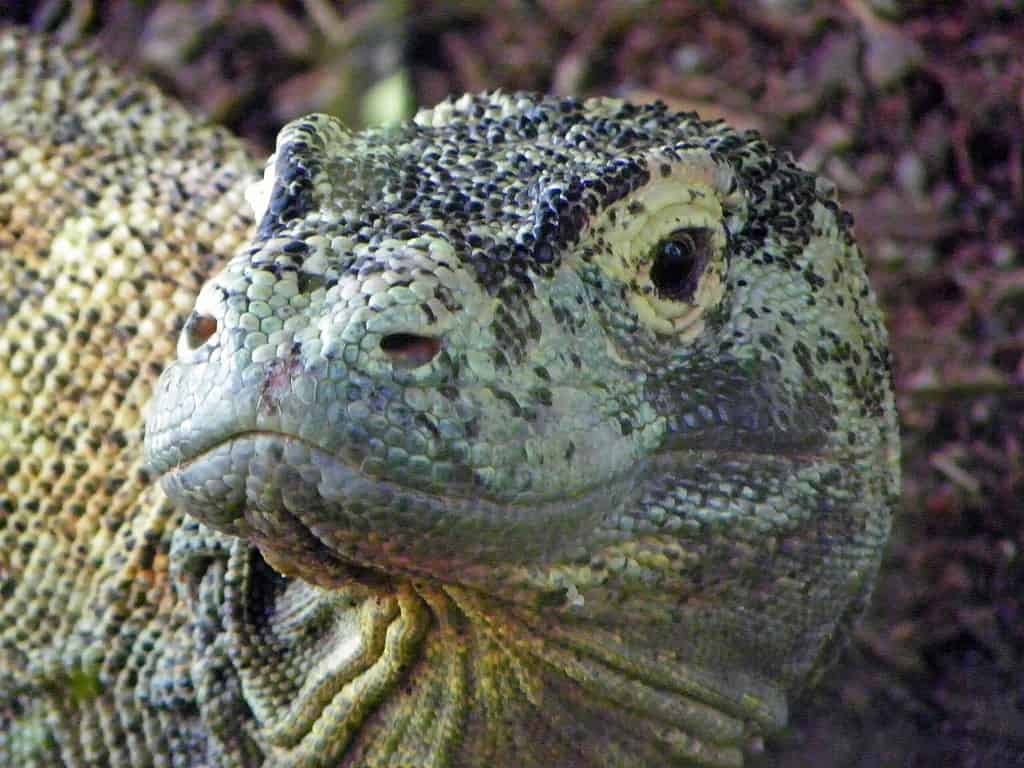
Probably the most dangerous of modern-day lizard dragons on this list, the Komodo Dragon is also the most like the monster dragon. The animal has a nasty bite filled with toxic venom that can kill a human within hours!
©Nehrams2020 / CC BY-SA 3.0 – License
The largest living lizard is the Komodo dragon, a true dragon in its own rights, even apart from legends. The giant lizard grows up to 10 feet in length and as big as 300 pounds. The carnivores are pretty fast, running up to 13 miles per hour, as they stalk and overpower their prey. The dragons can eat up to 80-percent of their body weight. A bite from one of these beasts will be extremely painful and could be fatal within hours. They don’t just have sharp teeth, but they produce a venom which is the killer. The living dragons are as ruthless and dangerous as the mythical fliers of old.
Black Dragon Lizard
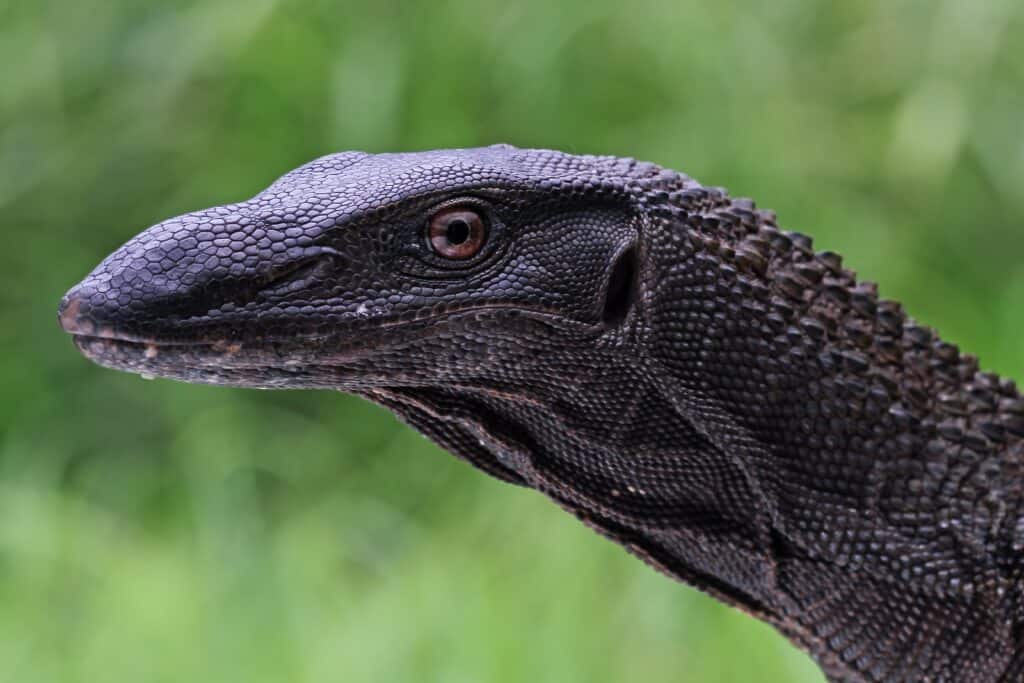
A black dragon lizard in solid black due to a genetic mutation. The creepy critters look like some image dragons to have looked once upon a time.
©Kurit afshen/Shutterstock.com
Falling within the monitor lizard family, the black dragon lizard honestly earns its name. The lizard does, indeed, look a bit like a dragon with its loose skin at the head and deep, intelligent eyes. The water monitors technically come from a color mutation, which makes all black coloring in the otherwise “standard” Asian water monitor. The lizard natively lives in southeast Asia, particularly on islands in Indonesia.
Red-eyed Crocodile Skink
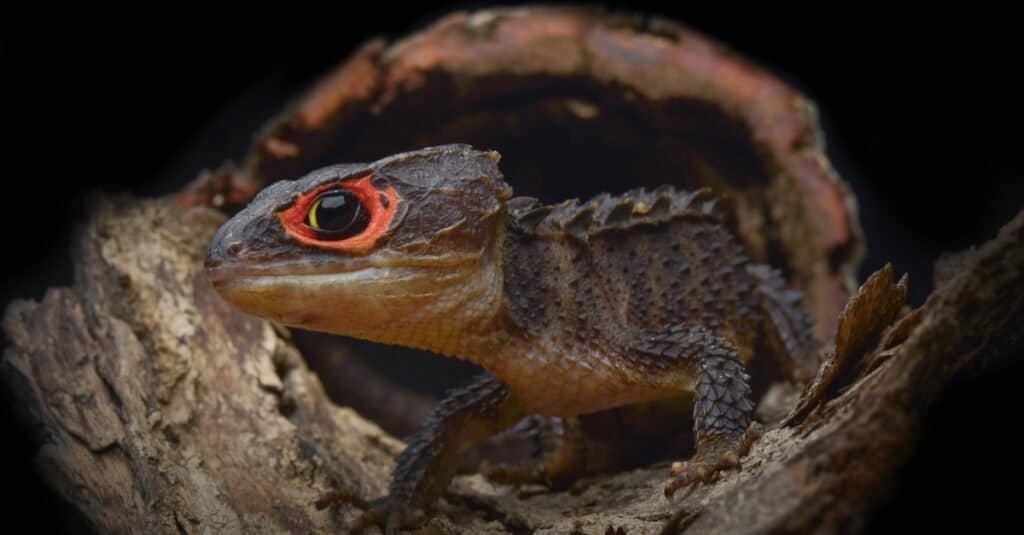
Possibly the cutest lizard on our list of dragon wannabes, the Red-eyed
Crocodile
Skink may be tiny, but it’s got fierce looks. The small critter makes for a great pet, too, so it’s the perfect choice for dragon fans.
©DWI YULIANTO/Shutterstock.com
Large red patches rest around the eyes of these little skinks. This helps the small lizards look a bit like dragons, especially up close. The Tribolonotus gracilis makes for a great pet, with their fun looks and even more fun personalities. They live up to 10 years as pets, feeding on mice, grubs, crickets, worms, roaches, and mealworms. The unique lizards originated on the isle of New Guinea in forest habitats with humid, hot environments.
Northern Caiman Lizard
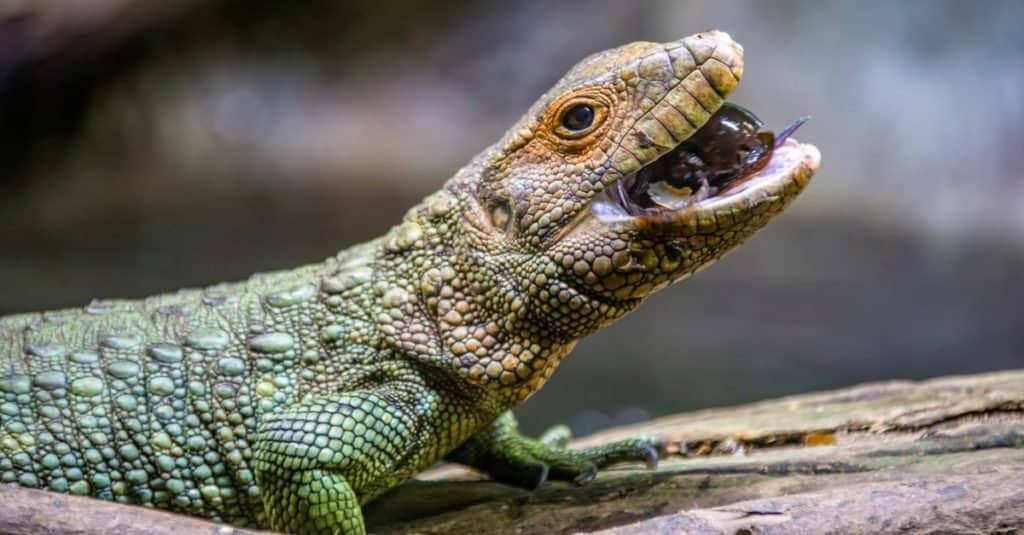
Northern Caiman Lizards look fierce despite their colorful armor-like scales. These lizards look like small, semi-aquatic painted dragons.
©Danny Ye/Shutterstock.com
If you want to raise your own dragon but have no experience, the colorful northern caiman lizard makes an excellent choice. These Dracaena guianensis live their lives as “painted”, semi-aquatic lizards that thrive swampy habitats in South America, when in the wild. Their colorful heads come in red to orange, with bright, tropical green shades on their bodies. The lizards grow between 2 and 4 feet long and weigh up to 10 pounds. They live on land and spend loads of time in the water, though this is mostly to cool off and hide from predators or seek their prey. The large scales covering their bodies protect them like armor and the sharp teeth and claws allow them to hunt easily on their own. They mostly eat snails, crawfish and other reptiles, with powerful jaws capable of biting even through turtle shells. These dragon wannabes are diurnal animals and sleep at night.
Philippine Sailfin Lizard

The Philippine Sailfin Lizard is an unusual dragon-like beast in the Philippines. The lizards, as juveniles, can actually run atop the water’s surface!
©Andi Siady Hamzah/Shutterstock.com
Scientifically known as Hydrosaurus pustulatus, the Philippine sailfin lizard enjoys life as an excellent swimmer, thanks to its webbed feet. The dragon-like critter also goes by soa-soa lizard or crested lizard. They live on several of the islands of the Philippines and these bizarre animals, when juvenile, can actually run atop the water, thanks to their unique physiques. They’re overall optimized for the island life with water capabilities, tree hanging capabilities, and the unique yellow or green camouflage blotches on their skin. They mostly live in tropical wooded areas near rivers.
Marine Iguana

The
Marine Iguana
live in the Galapagos Islands, living their best lives as remote dragon wannabes.
©iStock.com/Fred Chaveton
Only found in the Galapagos Islands, the marine iguana deserves its place on this list of dragon wannabes. The large Ecuadorian lizards are the only marine (ocean) lizard species in the world and many scientists believe they have evolved from land iguanas so that they could travel in the ocean’s waters to new terrain. Marine iguanas handle saltwater, even consuming it, expelling the salt from their bodies as waste.
Most often, you’ll find these lizards sporting black scales with large spikes running down their backs. The scales look like hardened armor, with their large claws edged with sharp points. They can’t breathe under water, but they can hold their breath for up to 40 minutes while they swim along looking for prey or moving to a new location. However, they generally eat algae while in the water, so if you come across one, you’ll want to stay away but you’re unlikely to be attacked.
Males of the species display bright reds, blues, and greens during mating season. The rest of the time, the dragon wannabes look like brown, green, yellow, and black lounge lizards on the beach.
Giant Girdled Lizard

The Giant Girdled Lizard may ring a bell with its scientific name smacking of Smaug. The thorny beast certainly qualifies as a dragon lookalike! Whether dragons were real or not, these giant lizards could take their place today.
©Wilfried Berns / CC BY 2.5 – License
If you’ve ever read or watched The Hobbit by J.R.R. Tolkien, the scientific name for the giant girdled lizard will ring a bell. The Smaug giganteus also goes by other names, including giant dragon lizard, ouvolk, and giant zonure. When you look at this creature, you know why it’s on the list of dragon lookalikes. For, indeed, this critter bears a strong resemblance to the legendary fire-breather. These lizards are native to South Africa, bearing occipital spines, large keeled caudal spines, and intimidating armor-like scales all over.
The photo featured at the top of this post is © Elena Zakhariya/Shutterstock.com
Thank you for reading! Have some feedback for us? Contact the AZ Animals editorial team.







